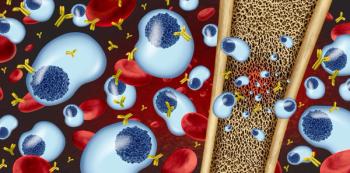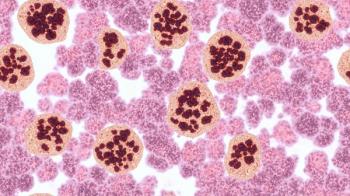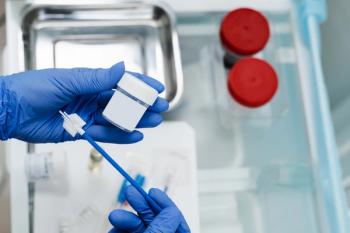
Therapeutic Drug Monitoring May Be Future of Inflammatory Bowel Disease Management

Therapeutic drug monitoring is a growing and vital area for pharmacists to become involved in to increase patient success with inflammatory bowel disease remission.
INTRODUCTION
Approximately 3 million US adults have been diagnosed with an inflammatory bowel disease (IBD), including Crohn disease and ulcerative colitis.1 Considering the prevalence of patients living with IBD, consistently appropriate disease management is crucial.
IBD has typically been managed with the goal of complete symptom remission, but best practices endorse a second goal of endoscopic remission (mucosal healing) to reduce disease progression and future risks. Clinical, laboratory, and endoscopic findings should all be used to drive therapeutic decision-making.2
Depending on the disease and its severity, different drugs can be introduced, including aminosalicylates, oral glucocorticoids, or immune-modifying agents (e.g., anti-TNF agents). Previously, a step-up approach was used for IBD, but now stronger agents are introduced sooner to, again, reduce the risks of disease progression and complications.3
While IBD management is complex and requires individualization regardless of the therapeutic agent being used, the immunological and pharmacokinetic variability in patients on immune-modifying agents increases the demand for treatment individualization and optimization. With patients specifically on these agents, the introduction of therapeutic drug monitoring (TDM) has increased the opportunity to better personalize and enhance pharmacotherapeutic regimens. This is a growing, yet vital area for pharmacists to become involved in to increase patient success with IBD remission.
AN INTRODUCTION TO TDM
TDM is the clinical practice of measuring drug levels in the bloodstream at specific times related to the dose of the medication. The goal is to achieve an appropriate therapeutic drug concentration and optimal dosing regimen. TDM is utilized in drugs characterized by narrow target ranges, significant pharmacokinetic variability, observed relationships between plasma concentrations and clinical effects, and established therapeutic concentration ranges.4-7
TDM can be approached either proactively or reactively. Proactive TDM utilizes regular measurements of drug-trough concentrations/anti-drug antibodies (ADAs) with dose adaptations to target therapeutically appropriate drug-trough concentrations. Reactive TDM works to rationalize primary non-response and secondary loss of response, encouraging alterations to dosages that will precipitate successful therapy.6
THE UTILITY OF TDM IN PRACTICE
Because IBD treatment is very much individualized to patients, the approaches of incorporating TDM into its management can vary depending on treatment stage. Regardless of its utilization, however, treatment is still evaluated via subjective and objective measures, including patient presentation, endoscopic findings, and changes in biomarkers (e.g., CRP, fecal calprotectin). Figures 1 and 2 illustrate how TDM can be integrated into IBD treatment.4,5
With the demonstrated opportunities to integrate TDM into IBD management, its use as a tool is expanding, especially as literature specifically addressing its incorporation in this population continues to grow. Considering their length of time on the market, anti-TNF agents, specifically infliximab and adalimumab, are the best studied drugs for the integration of TDM in IBD management.
Despite this growth of TDM practices, it is important to recognize limitations in evidence and application. The current literature does not unanimously endorse TDM of infliximab and adalimumab as a contributor to significantly improved patient outcomes.
Some evidence does suggest that the use of TDM for anti-TNF drugs is associated with enhanced cost effectiveness, better therapeutic outcomes, and safer treatment de-escalation. Other evidence available proposes that TDM-guided treatment changes do not lead to better outcomes than symptom-guided treatment, and that the benefits of TDM are conditional to when it is utilized during treatment (proactive versus reactive TDM).8-13
Most of the evidence supporting a positive correlation between drug concentrations and favorable therapeutic outcomes come from prospective studies and post-hoc analyses of randomized controlled trials (RCTs).4 For infliximab and adalimumab specifically, few RCTs analyzing this relationship have been completed. Figure 3 highlights the general conclusions of these trials.8-13
These trials suggest, generally, that proactive TDM methods may be more cost-effective, lead to higher rates of clinical remission, improve C-reactive protein (CRP) and fecal calprotectin levels, and increase events of sustained corticosteroid-free clinical remission.9–11 Some trials suggest no significant difference between TDM- and symptom-guided therapy changes, but this may be attributed to trial design and type of TDM employed.
The lower than recommended concentration targets, standardized timing of treatment changes, and slower dosage titrations utilized between these trials may not reflect what is done in current TDM practices. Additionally, the current literature mostly evaluates TDM in the maintenance phase of treatment, often post-optimization, which may not be the most comprehensive evaluation of this tool. Finally, the available evidence was based on mostly symptomatic and clinical remission, but as mentioned earlier, providers are shifting to also include endoscopic remission (mucosal healing) in the determination of treatment success.2
These RCTs cannot be purely relied on to guide decision-making, and as a result, many clinicians look toward the
The experts anticipate no difference between performing and interpreting the results of drug trough concentrations between originator biologics and their biosimilars.14 This said, only 2 of the trials (PANTS, NOR-DRUM) discussed included biosimilars in their studies, so more data are needed to solidify this statement.
CONCLUSION
The growing potential for TDM utilization in patients with IBD expands on our potential as a profession to be involved in the individualized management of these diseases. While more evidence is required to standardize the usage of this tool in current practice, some of the literature available and commentary provided by experts in the field are supportive of TDM in IBD management considering its association with improved patient outcomes and cost-effectiveness.
Additionally, there are 2 clinical trials underway that will hopefully continue to expand our knowledge and resolve previously demonstrated issues with trial design that altered their credibility.15,16 This said, the characterization of TDM being the future of IBD treatment optimization remains. With its expansion comes the expectation of pharmacists in both inpatient and outpatient settings to be knowledgeable in its utilization to optimize patient pharmacotherapy and overall outcomes.
About the Authors
Author: Jude Sammani, PharmD candidate, University of Arizona, Class of 2025
Preceptor: Ashley Sturm, PharmD, BCPS, Clinical Pharmacist, Mayo Clinic Medical Center-St. Mary’s Campus
References
- Prevalence of IBD. Centers for Disease Control and Prevention. April 14, 2022.
https://www.cdc.gov/ibd/data-and-statistics/prevalence.html . - Christensen B, Rubin DT. Understanding Endoscopic Disease Activity in IBD: How to Incorporate It into Practice. Curr Gastroenterol Rep. 2016;18(1):5. doi:10.1007/s11894-015-0477-6
- McDowell C, Farooq U, Haseeb M. Inflammatory Bowel Disease. [Updated 2023 Apr 16]. In: StatPearls [Internet]. Treasure Island (FL): StatPearls Publishing; 2023 Jan-. Available from:
https://www.ncbi.nlm.nih.gov/books/NBK470312/ . - Papamichael K, Afif W, Drobne D, et al. Therapeutic drug monitoring of biologics in inflammatory bowel disease: Unmet needs and future perspectives. The Lancet Gastroenterology & Hepatology. 2022;7(2):171-185. doi:10.1016/s2468-1253(21)00223-5
- Megna BW, Vaughn BP. Therapeutic drug monitoring in practice for inflammatory bowel disease. Current Gastroenterology Reports. 2022;24(12):191-200. doi:10.1007/s11894-022-00854-5
- Kang JS, Lee MH. Overview of therapeutic drug monitoring. Korean J Intern Med. 2009;24(1):1-10. doi:10.3904/kjim.2009.24.1.1
- Ghiculesco R. Abnormal laboratory results: Therapeutic Drug Monitoring: Which drugs, why, when and how to do it. Australian Prescriber. 2008;31(2):42-44. doi:10.18773/austprescr.2008.025
- Kennedy NA, Heap GA, Green HD, et al. Predictors of anti-TNF treatment failure in anti-TNF-naive patients with active luminal crohn’s disease: A prospective, Multicentre, cohort study. The Lancet Gastroenterology & Hepatology. 2019;4(5):341-353. doi:10.1016/s2468-1253(19)30012-3
- Strik AS, Löwenberg M, Mould DR, et al. Efficacy of dashboard driven dosing of infliximab in inflammatory bowel disease patients; a randomized controlled trial. Scandinavian Journal of Gastroenterology. 2020;56(2):145-154. doi:10.1080/00365521.2020.1856405
- Steenholdt C, Brynskov J, Thomsen OØ, et al. Individualised therapy is more cost-effective than dose intensification in patients with crohn’s disease who lose response to anti-TNF treatment: A randomised, controlled trial. Gut. 2013;63(6):919-927. doi:10.1136/gutjnl-2013-305279
- Vande Casteele N, Ferrante M, Van Assche G, et al. Trough concentrations of infliximab guide dosing for patients with inflammatory bowel disease. Gastroenterology. 2015;148(7). doi:10.1053/j.gastro.2015.02.031
- D’Haens G, Vermeire S, Lambrecht G, et al. Increasing infliximab dose based on symptoms, biomarkers, and serum drug concentrations does not increase clinical, endoscopic, and corticosteroid-free remission in patients with active luminal crohn’s disease. Gastroenterology. 2018;154(5). doi:10.1053/j.gastro.2018.01.004
- Syversen SW, Goll GL, Jørgensen KK, et al. Effect of Therapeutic Drug Monitoring vs Standard Therapy During Infliximab Induction on Disease Remission in Patients With Chronic Immune-Mediated Inflammatory Diseases: A Randomized Clinical Trial. JAMA. 2021;325(17):1744–1754. doi:1310.1001/jama.2021.4172
- Cheifetz AS, Abreu MT, Afif W, et al. A comprehensive literature review and expert consensus statement on therapeutic drug monitoring of biologics in inflammatory bowel disease. American Journal of Gastroenterology. 2021;116(10):2014-2025. doi:10.14309/ajg.0000000000001396
- The CURE - CD Trial. ClinicalTrials.gov identifier: NCT03555058. Updated: October 22, 2020. Accessed: June 14, 2023.
https://clinicaltrials.gov/ct2/show/NCT03555058 - TDM Guided Early Optimization of ADAL in Crohn’s Disease. ClinicalTrials.gov identifier: NCT03261102. Updated: April 4, 2023. Accessed: June 14, 2023.
https://clinicaltrials.gov/ct2/show/NCT03261102
Newsletter
Stay informed on drug updates, treatment guidelines, and pharmacy practice trends—subscribe to Pharmacy Times for weekly clinical insights.




















































































































































































































